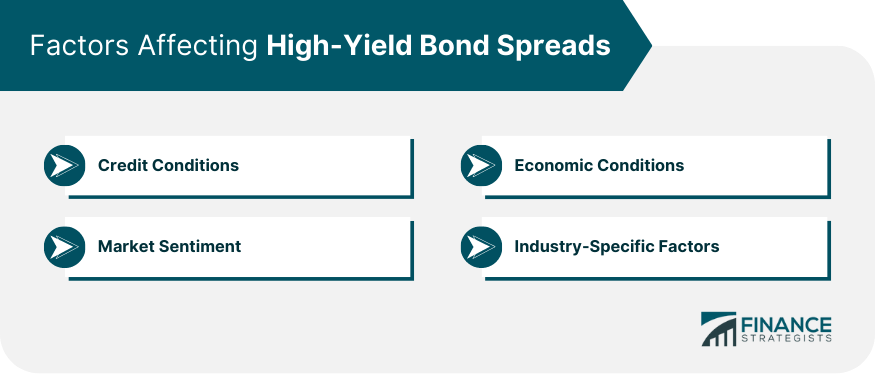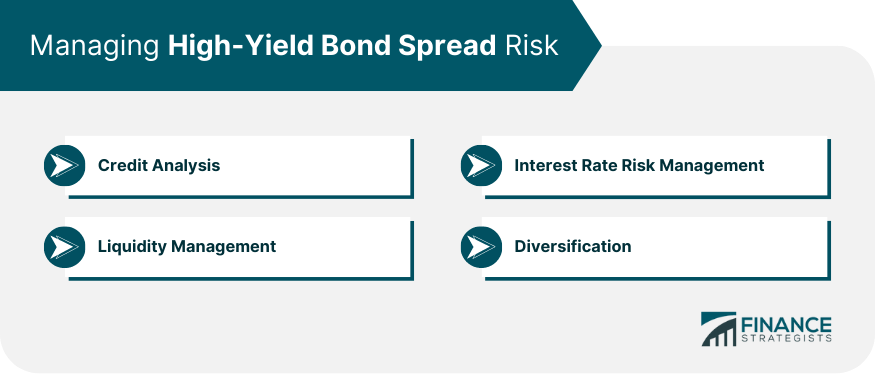The high-yield bond spread refers to the difference in yield between high-yield bonds and benchmark government securities of comparable maturity. It is a measure of the extra yield investors demand to compensate for the higher risk of default associated with high-yield bonds. High-yield bond spreads play a critical role in financial markets by reflecting the perceived credit risk of issuers, affecting the cost of capital for corporations, and providing insights into market sentiment and economic conditions. High-yield bonds, also known as junk bonds, are debt securities issued by companies with a lower credit rating than investment-grade bonds. They offer higher yields to compensate for the increased risk of default. Yield spread refers to the difference in yield between two securities or market benchmarks. In the case of high-yield bond spreads, it measures the additional yield demanded by investors to hold high-yield bonds compared to safer government bonds. High-yield bond spreads are typically calculated as the difference in yield between high-yield bonds and benchmark government bonds of comparable maturity, expressed as a percentage. High-yield bond spreads reflect the credit risk associated with the issuer of the bond. As credit risk increases, investors demand a higher yield to compensate for the greater likelihood of default. Consequently, high-yield bond spreads widen, indicating that investors perceive greater credit risk. Changes in credit conditions, such as upgrades or downgrades in credit ratings, can significantly impact high-yield bond spreads. Improvements in credit conditions can lead to tighter spreads, while deteriorating credit conditions can lead to wider spreads. Economic conditions, such as GDP growth, inflation, and unemployment, can affect high-yield bond spreads. Strong economic growth and low inflation tend to be associated with tighter spreads, while weak economic conditions and high inflation tend to be associated with wider spreads. Market sentiment, including investor risk appetite, can influence high-yield bond spreads. Positive sentiment can lead to tighter spreads, while negative sentiment can lead to wider spreads. Industry-specific factors, such as changes in commodity prices, regulatory changes, or supply and demand dynamics, can impact high-yield bond spreads for issuers within specific sectors. Investors seeking higher yields may consider investing in high-yield bonds, but they must also be aware of the increased risk of default associated with these securities. High-yield bonds can provide attractive returns, but they also require careful due diligence and risk management. High-yield bond spreads can serve as a useful measure of the credit risk associated with an issuer. Wider spreads indicate higher perceived risk, while tighter spreads suggest lower perceived risk. High-yield bonds can serve as a valuable diversification tool for investors seeking to balance risk and return in their portfolios. By including high-yield bonds in a diversified portfolio, investors can reduce overall portfolio risk while potentially enhancing returns. Effective credit analysis is essential for managing high-yield bond spread risk. Credit analysis involves evaluating an issuer's financial condition, industry trends, and management team to determine the likelihood of default. High-yield bond spreads can be sensitive to changes in interest rates. Managing interest rate risk through strategies such as duration matching and interest rate swaps can help investors mitigate the impact of interest rate changes on their high-yield bond investments. High-yield bonds can be illiquid, which can pose challenges for investors seeking to sell their holdings during market stress. Liquidity management strategies, such as maintaining cash reserves and avoiding overly concentrated positions, can help investors navigate periods of market volatility. Diversification is a critical risk management tool for high-yield bond investors. By investing in a range of high-yield bonds with varying maturities, industries, and credit ratings, investors can spread their risk and potentially enhance returns. High-yield bond spreads can serve as a leading economic indicator, reflecting changes in credit conditions and investor sentiment. Rising high-yield bond spreads can signal economic weakness or impending financial stress. Changes in high-yield bond spreads can impact other asset classes, such as equities and other fixed-income securities. Widening high-yield bond spreads can signal increased risk aversion and lead to broader market declines. Changes in high-yield bond spreads can have economic implications, such as impacting corporate borrowing costs and investment decisions. High-yield bond spreads can also influence monetary policy decisions by central banks. In conclusion, high-yield bond spreads play a vital role in the financial markets as they reflect the credit risk of issuers, affect the cost of capital for corporations, and provide insights into market sentiment and economic conditions. These spreads are determined by factors such as credit conditions, economic conditions, market sentiment, and industry-specific factors. Investors considering high-yield bonds should be aware of the increased risk of default associated with these securities but can benefit from higher yields and portfolio diversification. Effective risk management strategies include credit analysis, interest rate risk management, liquidity management, and diversification. High-yield bond spreads can also serve as leading economic indicators, impact other asset classes, and have economic implications such as influencing borrowing costs and monetary policy decisions. Understanding and managing high-yield bond spreads are crucial for investors and market participants alike. If you have assets that you want to protect and pass on to your loved ones, it's essential to have an estate plan in place. An experienced estate planning lawyer can help you create a plan that meets your specific needs and ensures that your wishes are carried out. What Is High-Yield Bond Spread?
Understanding High-Yield Bond Spreads
What are High-Yield Bonds?
What is Yield Spread?
Calculation of High-Yield Bond Spreads
How High-Yield Bond Spreads Reflect Credit Risk
Factors Affecting High-Yield Bond Spreads

Credit Conditions
Economic Conditions
Market Sentiment
Industry-Specific Factors
High-Yield Bond Spreads and Investing
Investing in High-Yield Bonds
High-Yield Bond Spreads as a Measure of Risk
Portfolio Diversification Using High-Yield Bonds
Managing High-Yield Bond Spread Risk

Credit Analysis
Interest Rate Risk Management
Liquidity Management
Diversification
High-Yield Bond Spreads and the Economy
High-Yield Bond Spreads as a Leading Economic Indicator
Impact of High-Yield Bond Spreads on Other Asset Classes
Economic Implications of Changes in High-Yield Bond Spreads
Final Thoughts
High-Yield Bond Spread FAQs
A high-yield bond spread refers to the difference in yield between high-yield bonds and benchmark government securities of comparable maturity. It is a measure of the extra yield investors demand to compensate for the higher risk of default associated with high-yield bonds.
High-yield bond spreads are typically calculated as the difference in yield between high-yield bonds and benchmark government bonds of comparable maturity, expressed as a percentage.
High-yield bond spreads reflect the credit risk associated with the issuer of the bond. As credit risk increases, investors demand a higher yield to compensate for the greater likelihood of default. Consequently, high-yield bond spreads widen, indicating that investors perceive greater credit risk.
Effective risk management is critical for investors in high-yield bonds, given the increased risk of default associated with these securities. Careful credit analysis, interest rate risk management, liquidity management, and diversification can help investors manage risk effectively.
Yes, changes in high-yield bond spreads can impact other asset classes, such as equities and other fixed-income securities. Widening high-yield bond spreads can signal increased risk aversion and lead to broader market declines.
True Tamplin is a published author, public speaker, CEO of UpDigital, and founder of Finance Strategists.
True is a Certified Educator in Personal Finance (CEPF®), author of The Handy Financial Ratios Guide, a member of the Society for Advancing Business Editing and Writing, contributes to his financial education site, Finance Strategists, and has spoken to various financial communities such as the CFA Institute, as well as university students like his Alma mater, Biola University, where he received a bachelor of science in business and data analytics.
To learn more about True, visit his personal website or view his author profiles on Amazon, Nasdaq and Forbes.













